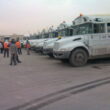Strong tremors rattled Delhi and its adjoining regions on Thursday morning after a 4.4 magnitude earthquake struck Jhajjar district in Haryana, prompting residents to rush out of homes and offices in panic. The earthquake occurred at 9:04 AM at a depth of 10 km, according to the National Centre for Seismology.
The tremors were felt across a wide swath of northern India, including Delhi, Gurugram, Noida, Rohtak, Bahadurgarh, Dadri, and even as far as Meerut and Shamli in western Uttar Pradesh—nearly 200 km from the epicentre.
In several parts of Delhi and Noida, people reported seeing ceiling fans shake and computers wobble, leading many to evacuate residential buildings and office complexes. Some described the tremor as “the longest they had ever felt.”
Social media platforms were quickly flooded with reactions, with users sharing experiences and videos showing swaying objects. The sense of unease was especially high due to the length and perceptibility of the tremor.
The National Disaster Response Force (NDRF) issued an advisory urging citizens to remain calm and avoid elevators. People were advised to evacuate buildings using staircases and, if driving, to pull over in open areas away from structures and trees.
Experts from the Delhi Disaster Management Authority (DDMA) reiterated that Delhi’s vulnerability stems from its location in Seismic Zone IV, which indicates a high risk of seismic activity. The region sits near several active fault lines, including the Delhi-Haridwar Ridge, Sohna Fault, Delhi-Moradabad Fault, and Mahendragarh-Dehradun Fault.
While Thursday’s tremor did not result in any reported injuries or damage, it served as a reminder of the capital’s seismic sensitivity. Since 1720, Delhi has experienced at least five earthquakes above 5.5 magnitude, according to historical data.











